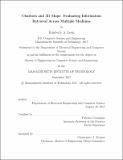| dc.contributor.advisor | Federico Casalegno. | en_US |
| dc.contributor.author | Leon, Kimberly A | en_US |
| dc.contributor.other | Massachusetts Institute of Technology. Department of Electrical Engineering and Computer Science. | en_US |
| dc.date.accessioned | 2018-12-11T20:39:02Z | |
| dc.date.available | 2018-12-11T20:39:02Z | |
| dc.date.copyright | 2017 | en_US |
| dc.date.issued | 2017 | en_US |
| dc.identifier.uri | http://hdl.handle.net/1721.1/119532 | |
| dc.description | Thesis: M. Eng., Massachusetts Institute of Technology, Department of Electrical Engineering and Computer Science, 2017. | en_US |
| dc.description | This electronic version was submitted by the student author. The certified thesis is available in the Institute Archives and Special Collections. | en_US |
| dc.description | Cataloged from student-submitted PDF version of thesis. | en_US |
| dc.description | Includes bibliographical references (pages 57-59). | en_US |
| dc.description.abstract | In this thesis, we present data retrieval accomplished through two extremes of affordance. First, a natural language understanding (NLU) driven chatbot, which has minimal affordance -- the only visual cue users are given is an empty text box, an initial greeting message, and a list of general topics the chatbot can respond to. Second, a table-mounted tactile / digital map display (tangible map), the proposed antithesis to the chatbot, which has maximal affordance -- users can see everything available to them through the combination of a three-dimensional map atop interactive touch-screens and a native iPad app. The two mediums described above were both implemented as pieces of a single larger project: the MIT Atlas Service Center, and are meant to showcase the talent and research that happens in each of the 5 schools of MIT. As the author's time was not spent equally between the two mediums during the design and implementation phases, the main focus of this thesis up until Chapter 5, User Studies, will be the chatbot, and the length and detail of the chatbot-related sections will reflect this. In this thesis, we describe the motivation behind both projects, as well as their design and technical development. We then describe the evaluation of both mediums, which involves user studies with the goal of evaluating information retrieval across multiple mediums (the chatbot, the tangible map, and existing, public information retrieval services, i.e. Google Search). Finally, We describe the conclusions we arrive at as a result of the collected user study data. Our primary contributions are the implemented chatbot and tangible map, as well as the insights learned due to the user studies performed with both mediums. | en_US |
| dc.description.statementofresponsibility | by Kimberly A. Leon. | en_US |
| dc.format.extent | 59 pages | en_US |
| dc.language.iso | eng | en_US |
| dc.publisher | Massachusetts Institute of Technology | en_US |
| dc.rights | MIT theses are protected by copyright. They may be viewed, downloaded, or printed from this source but further reproduction or distribution in any format is prohibited without written permission. | en_US |
| dc.rights.uri | http://dspace.mit.edu/handle/1721.1/7582 | en_US |
| dc.subject | Electrical Engineering and Computer Science. | en_US |
| dc.title | Chatbots and 3D maps : evaluating information retrieval across multiple mediums | en_US |
| dc.title.alternative | Chatbots and 3-Dimensional maps | en_US |
| dc.type | Thesis | en_US |
| dc.description.degree | M. Eng. | en_US |
| dc.contributor.department | Massachusetts Institute of Technology. Department of Electrical Engineering and Computer Science | |
| dc.identifier.oclc | 1066740995 | en_US |
